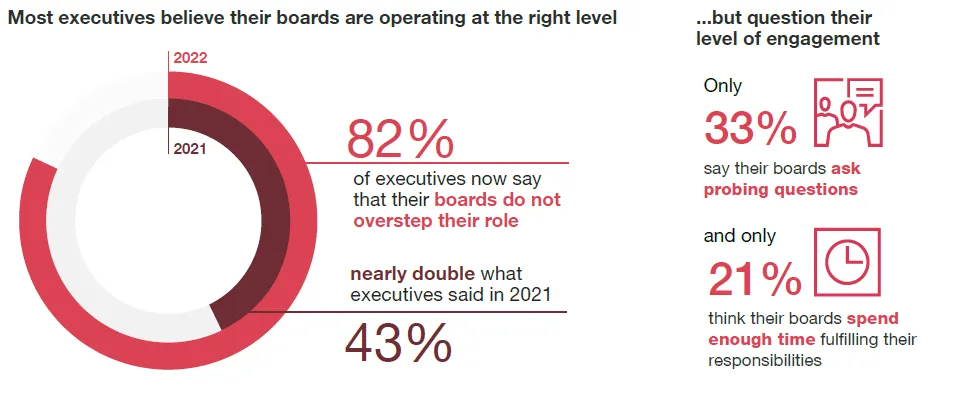
Bridging Boardroom Divides: Conflict to Consensus
Navigating the boardroom of a startup presents unique challenges, often serving as a melting pot of varied opinions of founders, investors, and board members. These differing perspectives, stemming from individual expectations about the company’s future direction, growth speed, and market engagement, can create a misalignment of expectations and outcomes. Without a unified approach, such disparities may escalate into conflicts as each party champions strategies they believe will advance their interests or the broader objectives of the company.
Conflict in the boardroom is inevitable, but it can be transformed into ‘constructive criticism’.
It is crucial to recognize that 'tension' and 'conflict' are distinct forces within the boardroom. Tension involves disagreements that, although uncomfortable, can typically be resolved through healthy debate. Conflict, however, is more severe - regarded as aggressive tension that escalates to extreme and often unresolvable levels, adversely impacting board dynamics. Nevertheless, when managed correctly, tension can foster a constructive outcome-centric approach.
Unpacking Boardroom Conflicts
Boardroom conflicts can have a significant impact on organizations depending on the nature of the conflict.
- 29.6% had experience with a boardroom dispute affecting the survival of an organization.
- Interestingly, board members feel more confident in resolving internal disputes—with 58.5% believing they can effectively manage these—compared to external disputes involving the board and external stakeholders, where only about 24.3% feel they can achieve resolution.

Recognising Roots of Boardroom Conflict
Boardroom conflicts in startups often stem from the interplay between cognitive dissonance and board cohesiveness. Cognitive conflicts arise when board members encounter information that challenges their pre-existing beliefs, leading to strategic misalignment as the company evolves. Such misalignments are particularly pronounced in startups where rapid growth and evolving visions heighten tensions.
A thorough understanding of boardroom dynamics necessitates consideration of the following key aspects:
- Key Dynamics and Conflict Climates
- Cognitive Conflict and Board Cohesion: A study by Engbers and Khapova reveals that most boards avoid cognitive conflict, fearing it will lead to affective conflict and diminish cohesiveness. This avoidance leads to discussions being confined to non-contentious topics or resolved through informal gossiping, which ultimately hampers board performance.some text
- Cognitive conflict – The term is used for the cognitive dissonance resulting from being confronted by information contradicting someone's prior beliefs and ideas.
- Board cohesion - Cohesion in boards essentially reflects the “board's ability to continue working together
- Conflict Climates: Understanding the various conflict climates within a boardroom is crucial for effective governance and decision-making. As per the study by Engbers and Khapova, identifies four distinct conflict climates that influence how boards operate and resolve issues:some text
- Compliance Climate: Conflict is avoided to maintain a facade of harmony, stifling genuine dialogue and critical discussions.
- Pseudo-cohesive Climate: Boards may appear cohesive, but underlying tensions and unspoken disagreements prevent real alignment on decisions.
- Conflict Climate: Characterized by frequent and open conflicts, which, while potentially disruptive, can lead to clearer resolutions and innovative solutions if managed well.
- Agree-to-Disagree Climate: Boards accept and manage disagreements, maintaining cohesiveness while allowing diverse viewpoints to coexist, fostering a more dynamic decision-making process.
- Specific Startup Challenges
Startups encounter distinctive challenges that complicate decision-making and strategic alignment, including navigating emerging market dynamics, managing diverse stakeholder interests, and addressing intense pressures from rapid growth. These challenges often manifest in the following ways:
a) Divergent Visions and Strategic Misalignment: Startups often begin with a shared vision, but as they evolve, founders, board, and key stakeholders may develop different ideas about the direction of the company. This can lead to strategic misalignment, where the goals and methods of achieving success no longer sync up, causing friction in the boardroom. 34% of boards indicated that they had no shared view on mission, vision, or strategy, and 66% that there was a known, difficult but critical issue that board members felt too uncomfortable to raise.
b) Growth Pressures and Resource Allocation: The rapid growth phase of startups can create intense pressure on the board to perform and deliver results. Decisions on resource allocation can become contentious, as board members debate the best use of limited resources to sustain growth and satisfy stakeholders.
c) Emotional Intelligence and Relationship Dynamics: Founders and early investors often have strong emotional ties to the startup, which can cloud judgment and escalate conflicts. The intricate personal relationships and dynamics between board members may complicate decision-making further. In high-stress environments like startups, the mix of strong personalities and potential miscommunications can readily trigger conflicts.
- Impact on Board Dynamic
The key factors influencing board dynamics are:
- Board Cohesiveness: Essential for effective functioning but can be undermined by cognitive conflicts unless strong norms and management styles promote constructive engagement. The perceived "board temperature" and the level of "unsaid tensions” significantly impact cohesiveness. High levels of unsaid tensions lead to process conflicts and affective conflicts, reducing overall cohesiveness.
- Perceived Board Temperature: Refers to the general atmosphere within the board. A positive temperature fosters open dialogue, while a negative temperature stifles communication and increases hidden tensions.
- Level of Unsaid Tensions: High levels of unsaid tensions indicate unresolved issues. When board members silently harbour serious concerns, it leads to affective conflicts, reducing overall cohesiveness. Regular checks and encouraging open communication can help address these underlying issues, enhancing the board's functionality and decision-making efficacy.
- Conflict Norms Formation: Continuous and implicit development of conflict norms based on power dynamics and individual behaviours significantly influences board interactions. Board members often avoid raising concerns due to fear of eliciting affective conflict, resorting to confidential gossiping instead.
- Dominant Conflict Management Style: The prevailing approach to handling disagreements can either mitigate or exacerbate tensions within the board. Effective conflict management styles prevent cognitive conflicts from escalating into affective conflicts, thus maintaining cohesiveness.
How to Resolve Boardroom Conflict Effectively?
Enhancing board effectiveness through strategic conflict management is crucial for maintaining a productive and harmonious environment. The key strategies, to address conflicts are:
- Empowering the Chairperson: The chairperson should effectively lead and navigate meetings, keeping discussions relevant and fostering empathy among members. This leadership is crucial for maintaining focus and ensuring productive outcomes. An effective chairperson helps manage disputes by setting the tone and ensuring all voices are heard.

Interestingly, a PWC survey reveals only 29% of the respondents rate their board’s overall performance as excellent or good, indicating significant room for improvement. Additionally, an IFC survey found that 68.3% of respondents believe that the ability to chair an effective meeting is a crucial skill for board members, underscoring the importance of skilled leadership in conflict management."
The strategic approach the chairperson can consider that foster resolution and collaboration are:
- Structured Conflict Resolution Processes: Implementing formal methodologies like mediation and structured dialogue can help systematically address disputes, providing a clear path toward resolution and preventing conflicts from escalating.
- Regular Conflict Resolution Training: Equipping board members with negotiation and communication skills through regular training enhances their ability to handle disagreements constructively.
- Creating a Conflict Resolution Framework: Developing a board-specific framework that outlines the steps for conflict resolution ensures a consistent approach that all members understand and can follow.
Case Study 1: Ford Motor Company - Alan Mulally’s Leadership
Ford was facing severe financial difficulties and internal disagreements over the direction of the company.
- Strategic Changes by the Chairperson: Alan Mulally, as CEO and Chairperson, emphasized clear, structured communication and a collaborative approach in leadership meetings. He introduced a series of regular meetings where executives were required to use a standardized format to report on progress and challenges. This not only increased transparency but also allowed Mulally to take a more directive role in steering discussions and resolving conflicts.
- Impact of Empowering the Chairperson:
- Reduction in Conflicts: By centralizing the communication, Mulally reduced passive-aggressive behaviour among executives and prevented the formation of silos, which were a major source of conflict previously. His direct involvement and structured approach to meetings meant that issues were addressed openly and quickly, before escalating into larger conflicts.
- Improved Decision-Making: With Mulally’s leadership, Ford experienced a turnaround from a $12.7 billion loss in 2006 to a $6.6 billion profit in 2010. His ability to directly influence boardroom discussions and decisions played a critical role in this recovery.
- Key Takeaway: This case underscores the importance of a strong chairperson who can enforce structure and open communication in board meetings, leading to more effective governance and reduced conflicts. Mulally’s role at Ford demonstrates how centralizing power in the chairperson’s hands, when coupled with a focus on transparency and accountability, can transform company leadership and mitigate internal disputes effectively.
- Acknowledge and Directly Address Conflict: Recognizing that conflicts are a natural part of board dynamics is essential. Board chairs and members should not shy away from addressing conflicts as they arise. Adopting a proactive stance, rather than a reactive or avoidance approach, can lead to more productive resolutions. Effective conflict management involves identifying the conflict early, understanding the underlying issues, and addressing these issues constructively. This approach not only resolves the immediate disagreement but also strengthens the board’s ability to handle future conflicts, contributing to a more resilient governance structure.
- Clarify Roles of Board and committee and Foster Open Communication: Ensuring that every board member clearly understands their roles and responsibilities helps in preventing misunderstandings that often lead to conflict. Simultaneously, fostering a culture of transparency where members feel comfortable voicing their opinions not only builds trust but also ensures comprehensive consideration in decision-making. This dual approach of clarity and openness is vital for pre-emptively addressing concerns and maintaining professional conduct within the board.

- Establish Guidelines and Address Conflicts Professionally: Setting clear standards of behaviour through a formal code of conduct promotes consistency, accountability, and respect among board members. This framework is crucial in preventing conflicts from escalating by establishing expected behaviours. When conflicts do arise, addressing them head-on, with a focus on problem-solving rather than personal differences, is crucial. This method emphasizes resolving the underlying causes of disagreements and fosters a culture of teamwork and mutual respect.
- Data-Driven Decisions and Regular Reviews: Making decisions based on solid, unbiased data can significantly reduce personal biases and enhance objectivity, thereby minimizing the potential for conflict. Regularly assessing board performance and dynamics is also essential. These reviews help maintain a healthy board environment and promote continuous improvement, catching underlying tensions before they evolve into significant conflicts.


- Enhance Interaction and Conflict Resolution Skills: Encouraging informal interactions outside of formal meetings can strengthen relationships and ease tensions among board members. Additionally, providing conflict resolution training equips them with essential skills to manage disputes effectively and maintain professionalism during heated discussions.
Case Study 2: Airbus - Enhancing Interaction and Conflict Resolution
In 2020, Airbus, one of the world’s leading aerospace companies, faced significant boardroom conflicts due to strategic disagreements and communication breakdowns among its leadership team. This was exacerbated by the challenges posed by the COVID-19 pandemic, which severely impacted the aviation industry.
- Strategy Implemented:
- Informal Interactions: Airbus introduced informal gatherings and team-building activities outside of formal board meetings to foster stronger personal relationships among board members. These events included retreats and social outings designed to build trust and camaraderie.
- Conflict Resolution Training: The company provided extensive conflict resolution training for its board members, focusing on skills such as active listening, empathy, and effective negotiation techniques. This training aimed to equip board members with the tools needed to handle disputes professionally and constructively.
- Outcomes:
- Improved Relationships: The informal interactions helped break down barriers, leading to improved personal relationships and better communication among board members.
- Enhanced Problem-Solving: With enhanced conflict resolution skills, board members were able to address disagreements more effectively, leading to more cohesive and strategic decision-making.
- Key Takeaway: Airbus’s approach highlights the importance of fostering informal interactions and providing conflict resolution training to manage boardroom conflicts effectively. These strategies not only improve professional relationships but also enhance the board’s ability to navigate complex challenges, ensuring better governance and decision-making during critical times.
Conclusion
“Corporate governance is not about structure or checklists or best practices. It is about substance and outcomes”
In the entrepreneurial journey, the boardroom is a strategic battleground where the future of a startup is decided. Effective governance and adept conflict management are crucial for innovation and growth. Think of corporate governance as the defining element in risk management, ensuring the right questions are asked and checks and balances are in place. By fostering transparency, strategic alignment, and dynamic conflict resolution, founders can turn governance into a competitive edge, propelling their ventures to market leadership. Smart governance transforms boardroom challenges into opportunities for building a resilient, visionary enterprise.
DISCLAIMER
The views expressed herein are those of the author as of the publication date and are subject to change without notice. Neither the author nor any of the entities under the 3one4 Capital Group have any obligation to update the content. This publications are for informational and educational purposes only and should not be construed as providing any advisory service (including financial, regulatory, or legal). It does not constitute an offer to sell or a solicitation to buy any securities or related financial instruments in any jurisdiction. Readers should perform their own due diligence and consult with relevant advisors before taking any decisions. Any reliance on the information herein is at the reader's own risk, and 3one4 Capital Group assumes no liability for any such reliance.Certain information is based on third-party sources believed to be reliable, but neither the author nor 3one4 Capital Group guarantees its accuracy, recency or completeness. There has been no independent verification of such information or the assumptions on which such information is based, unless expressly mentioned otherwise. References to specific companies, securities, or investment strategies are not endorsements. Unauthorized reproduction, distribution, or use of this document, in whole or in part, is prohibited without prior written consent from the author and/or the 3one4 Capital Group.




.webp)









